2017 NISSAN TITAN check engine
[x] Cancel search: check enginePage 601 of 671
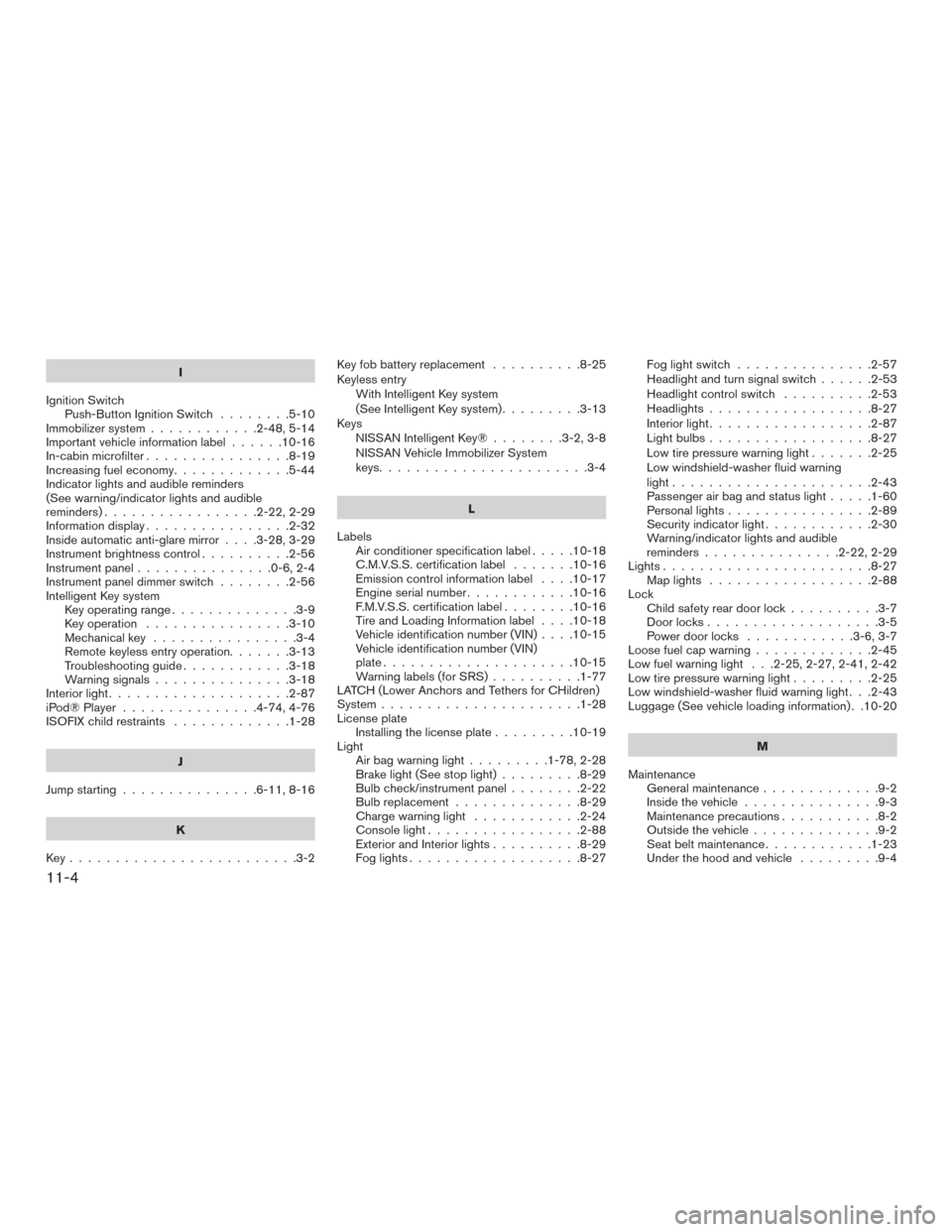
I
Ignition Switch Push-Button Ignition Switch ........5-10
Immobilizer system ............2-48,5-14
Important vehicle information label ......10-16
In-cabin microfilter ................8-19
Increasing fuel economy .............5-44
Indicator lights and audible reminders
(See warning/indicator lights and audible
reminders).................2-22,2-29
Informationdisplay................2-32
Inside automatic anti-glare mirror ....3-28,3-29
Instrument brightness control ..........2-56
Instrument panel ...............0-6,2-4
Instrument panel dimmer switch ........2-56
Intelligent Key system Key operating range ..............3-9
Key operation ................3-10
Mechanicalkey ................3-4
Remote keyless entry operation.......3-13
Troubleshooting guide ............3-18
Warning signals ...............3-18
Interiorlight....................2-87
iPod®Player ...............4-74,4-76
ISOFIX child restraints .............1-28
J
Jump starting ...............6-11,8-16
K
Key.........................3-2 Keyfobbatteryreplacement ..........8-25
Keyless entry
With Intelligent Key system
(See Intelligent Key system) .........3-13
Keys NISSAN Intelligent Key® ........3-2,3-8
NISSAN Vehicle Immobilizer System
keys.......................3-4
L
Labels Air conditioner specification label .....10-18
C.M.V.S.S. certification label .......10-16
Emission control information label ....10-17
Engine serial number ............10-16
F.M.V.S.S. certification label ........10-16
Tire and Loading Information label ....10-18
Vehicle identification number (VIN) ....10-15
Vehicle identification number (VIN)
plate.....................10-15
Warning labels (for SRS) ..........1-77
LATCH (Lower Anchors and Tethers for CHildren)
System ......................1-28
License plate Installing the license plate .........10-19
Light Air bag warning light .........1-78,2-28
Brake light (See stop light) .........8-29
Bulb check/instrument panel ........2-22
Bulbreplacement..............8-29
Charge warning light ............2-24
Consolelight.................2-88
Exterior and Interior lights ..........8-29
Foglights...................8-27 Fog light switch
...............2-57
Headlightandturnsignalswitch......2-53
Headlight control switch ..........2-53
Headlights..................8-27
Interiorlight..................2-87
Lightbulbs..................8-27
Low tire pressure warning light .......2-25
Low windshield-washer fluid warning
light......................2-43
Passenger air bag and status light .....1-60
Personal lights ................2-89
Security indicator light ............2-30
Warning/indicator lights and audible
reminders ...............2-22,2-29
Lights.......................8-27 Maplights ..................2-88
Lock Child safety rear door lock ..........3-7
Door locks ...................3-5
P
ower door locks ............3-6,3-7
Loose fuel cap warning .............2-45
Low fuel warning light . . .2-25, 2-27, 2-41, 2-42
Low tire pressure warning light .........2-25
Low windshield-washer fluid warning light . . .2-43
Luggage (See vehicle loading information) . .10-20
M
Maintenance General maintenance .............9-2
Insidethevehicle...............9-3
Maintenance precautions ...........8-2
Outside the vehicle ..............9-2
Seat belt maintenance ............1-23
Under the hood and vehicle .........9-4
11-4
Page 602 of 671
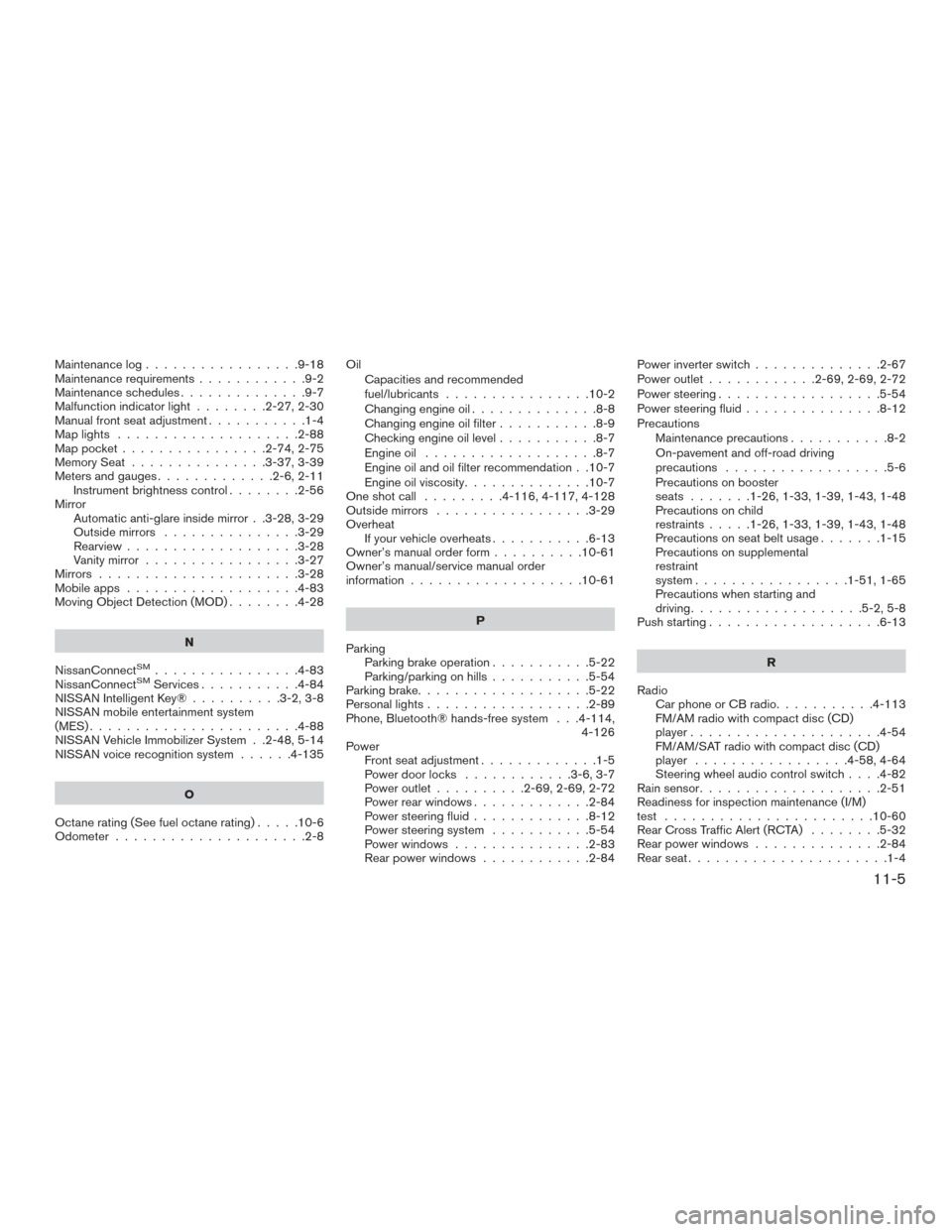
Maintenance log.................9-18
Maintenance requirements ............9-2
Maintenance schedules ..............9-7
Malfunction indicator light ........2-27,2-30
Manual front seat adjustment ...........1-4
Maplights ....................2-88
Map pocket ................2-74,2-75
Memory Seat ...............3-37,3-39
Meters and gauges .............2-6,2-11
Instrument brightness control ........2-56
Mirror Automatic anti-glare inside mirror . .3-28, 3-29
Outside mirrors ...............3-29
Rearview ...................3-28
Vanity mirror .................3-27
Mirrors ......................3-28
Mobileapps ...................4-83
Moving Object Detection (MOD) ........4-28
N
NissanConnect
SM................4-83
NissanConnectSMServices...........4-84
NISSAN Intelligent Key® ..........3-2,3-8
NISSAN mobile entertainment system
(MES) .......................4-88
NISSAN Vehicle Immobilizer System . .2-48, 5-14
NISSAN voice recognition system ......4-135
O
Octanerating(Seefueloctanerating).....10-6
Odometer .....................2-8 Oil
Capacities and recommended
fuel/lubricants ................10-2
Changingengineoil..............8-8
Changing engine oil filter ...........8-9
Checking engine oil level ...........8-7
Engine oil ...................8-7
Engine oil and oil filter recommendation . .10-7
Engine oil viscosity ..............10-7
Oneshotcall .........4- 116, 4-117, 4-128
Outside mirrors .................3-29
Overheat If your vehicle overheats ...........6-13
Owner’s manual order form ..........10-61
Owner’s manual/service manual order
information ...................10-61
P
Parking Parking brake operation ...........5-22
Parking/parking on hills ...........5-54
Parking brake ...................5-22
Personallights..................2-89
Phone, Bluetooth® hands-free system . . .4-114, 4-126
Power Front seat adjustment .............1-5
Power door locks ............3-6,3-7
Power outlet ..........2-69,2-69,2-72
Power rear windows .............2-84
Power steering fluid .............8-12
Power steering system ...........5-54
Power windows ...............2-83
Rear power windows ............2-84 Power inverter switch
..............2-67
Power outlet ............2-69,2-69,2-72
Power steering ..................5-54
Power steering fluid ...............8-12
Precautions Maintenance precautions ...........8-2
On-pavement and off-road driving
precautions ..................5-6
Precautions on booster
seats .......1-26,1-33,1-39,1-43,1-48
Precautions on child
restraints .....1-26,1-33,1-39,1-43,1-48
Precautions on seat belt usage .......1-15
Precautions on supplemental
restraint
system .................1-51,1-65
Precautions when starting and
driving ...................5-2,5-8
Push starting ...................6-13
R
Radio CarphoneorCBradio...........4-113
FM/AM radio with compact disc (CD)
player .....................4-54
FM/AM/SAT radio with compact disc (CD)
player .................4-58,4-64
Steering wheel audio control switch . . . .4-82
Rainsensor....................2-51
Readiness for inspection maintenance (I/M)
test .......................10-60
Rear Cross Traffic Alert (RCTA) ........5-32
Rear power windows ..............2-84
Rearseat......................1-4
11-5
Page 614 of 671

Preventive maintenance is the easiest and least
expensive type of maintenance. Keep records of
regularly scheduled maintenance and follow the
maintenance schedule recommendations out-
lined in the “Titan Owner’s Manual”.
Use the correct fuel, lubricating oil, and coolant in
your engine. Blending engine oil with fuel is pro-
hibited for engines with an aftertreatment system.
For additional information, refer to the “Capaci-
ties and Specifications” section in this manual.
A NISSAN dealership knows your vehicle. When
you require any service or have any questions,
they will be glad to assist you with the extensive
resources available to them.
DIESEL ENGINE OPERATION
The operation of the diesel engine in your new
vehicle varies from the operation of traditional
gasoline engines found in other vehicles. Read-
ing this supplement will familiarize you and other
operators of the vehicle with the unique mainte-
nance and operating procedures that will prolong
the life of the diesel engine and related systems.
ENGINE BREAK-IN
RECOMMENDATIONS
●Warm up the engine before operating it un-
der load
● Do not operate the engine at idle for ex-
tended periods
● Prevent engine lugging by selecting the ap-
propriate transmission gear
● Monitor the vehicle oil pressure and tem-
perature gauges
● Check fluid levels frequently (Oil & Coolant)
● Vary the throttle position at highway speeds
when carrying weight or towing
NOTE:
Extended light or no load operation will
extend the time before the engine reaches
its full efficiency. If the engine is operated
in this manner, reduced fuel economy and
power may be observed.
The aforementioned procedure should be ob-
served for the first 6,000 miles. The engine run-in
is improved by operating the vehicle under load.
DIESEL FUEL SYSTEM
The diesel engine fuel system is a pressurized
two-stage filtration system and consists of: ● A frame-mounted primary (stage 1) fuel filter
containing water/fuel separator, electric fuel
pump, and water in fuel drain valve
● An engine-mounted secondary (stage 2)
fuel filter
● A fuel injector for each cylinder (8 total)
● A high-pressure fuel pump
● A high-pressure fuel rail for each cylinder
bank (2 total)
● High-pressure fuel lines from the high-
pressure fuel pump to the right bank fuel rail,
right bank fuel rail to the left bank fuel rail,
and fuel rails to fuel injectors.
The stage 1 fuel filter separates water and filters
impurities from the fuel. The stage 2 fuel filter
filters finer impurities from the diesel fuel. The
stage 1 and stage 2 fuel filters should be
changed at the recommended service interval or
when indicated by the information display. For
additional information, refer to the “Titan Owner’s
Manual”.
GENERAL INFORMATION
1-2Introduction
Page 615 of 671
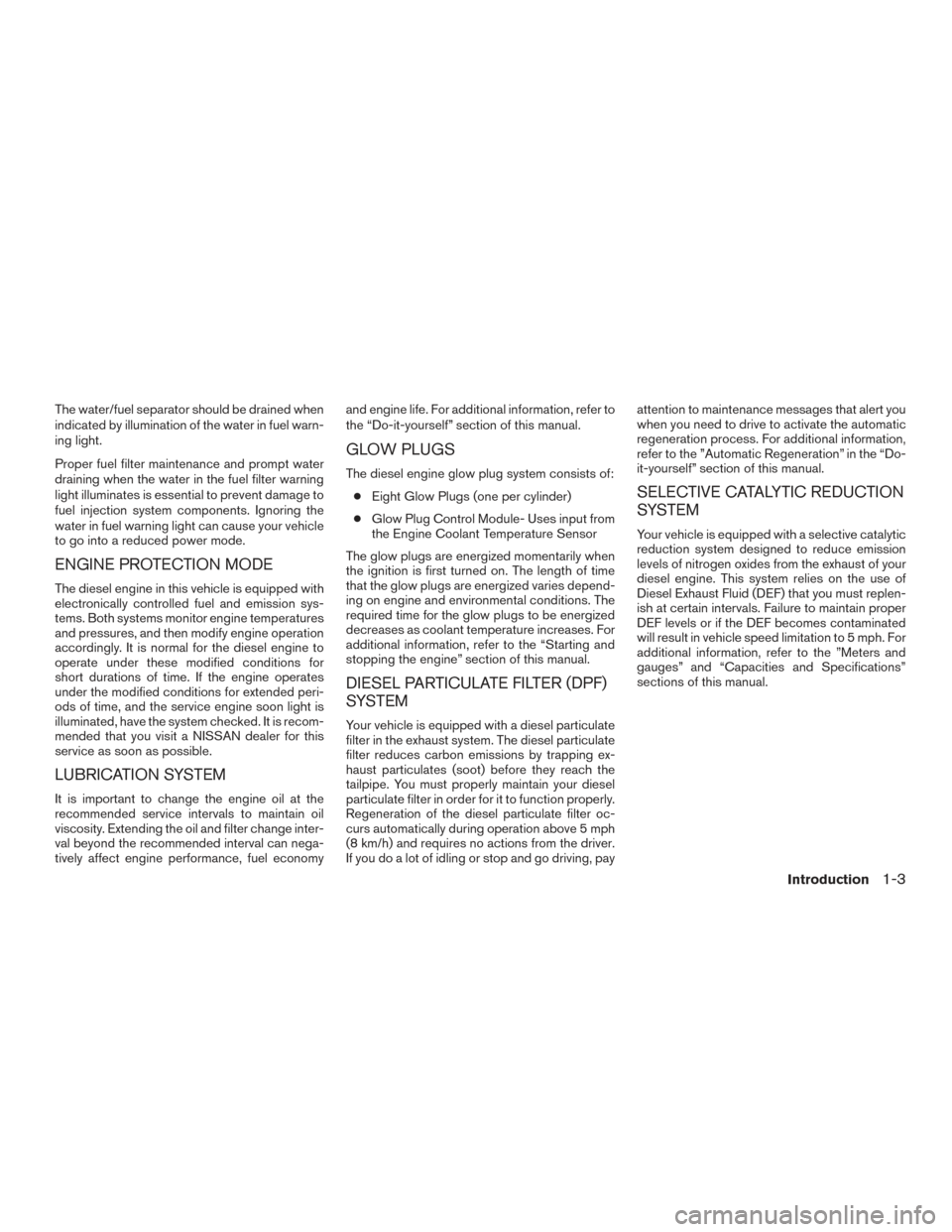
The water/fuel separator should be drained when
indicated by illumination of the water in fuel warn-
ing light.
Proper fuel filter maintenance and prompt water
draining when the water in the fuel filter warning
light illuminates is essential to prevent damage to
fuel injection system components. Ignoring the
water in fuel warning light can cause your vehicle
to go into a reduced power mode.
ENGINE PROTECTION MODE
The diesel engine in this vehicle is equipped with
electronically controlled fuel and emission sys-
tems. Both systems monitor engine temperatures
and pressures, and then modify engine operation
accordingly. It is normal for the diesel engine to
operate under these modified conditions for
short durations of time. If the engine operates
under the modified conditions for extended peri-
ods of time, and the service engine soon light is
illuminated, have the system checked. It is recom-
mended that you visit a NISSAN dealer for this
service as soon as possible.
LUBRICATION SYSTEM
It is important to change the engine oil at the
recommended service intervals to maintain oil
viscosity. Extending the oil and filter change inter-
val beyond the recommended interval can nega-
tively affect engine performance, fuel economyand engine life. For additional information, refer to
the “Do-it-yourself” section of this manual.
GLOW PLUGS
The diesel engine glow plug system consists of:
● Eight Glow Plugs (one per cylinder)
● Glow Plug Control Module- Uses input from
the Engine Coolant Temperature Sensor
The glow plugs are energized momentarily when
the ignition is first turned on. The length of time
that the glow plugs are energized varies depend-
ing on engine and environmental conditions. The
required time for the glow plugs to be energized
decreases as coolant temperature increases. For
additional information, refer to the “Starting and
stopping the engine” section of this manual.
DIESEL PARTICULATE FILTER (DPF)
SYSTEM
Your vehicle is equipped with a diesel particulate
filter in the exhaust system. The diesel particulate
filter reduces carbon emissions by trapping ex-
haust particulates (soot) before they reach the
tailpipe. You must properly maintain your diesel
particulate filter in order for it to function properly.
Regeneration of the diesel particulate filter oc-
curs automatically during operation above 5 mph
(8 km/h) and requires no actions from the driver.
If you do a lot of idling or stop and go driving, pay attention to maintenance messages that alert you
when you need to drive to activate the automatic
regeneration process. For additional information,
refer to the ”Automatic Regeneration” in the “Do-
it-yourself” section of this manual.
SELECTIVE CATALYTIC REDUCTION
SYSTEM
Your vehicle is equipped with a selective catalytic
reduction system designed to reduce emission
levels of nitrogen oxides from the exhaust of your
diesel engine. This system relies on the use of
Diesel Exhaust Fluid (DEF) that you must replen-
ish at certain intervals. Failure to maintain proper
DEF levels or if the DEF becomes contaminated
will result in vehicle speed limitation to 5 mph. For
additional information, refer to the ”Meters and
gauges” and “Capacities and Specifications”
sections of this manual.
Introduction1-3
Page 621 of 671
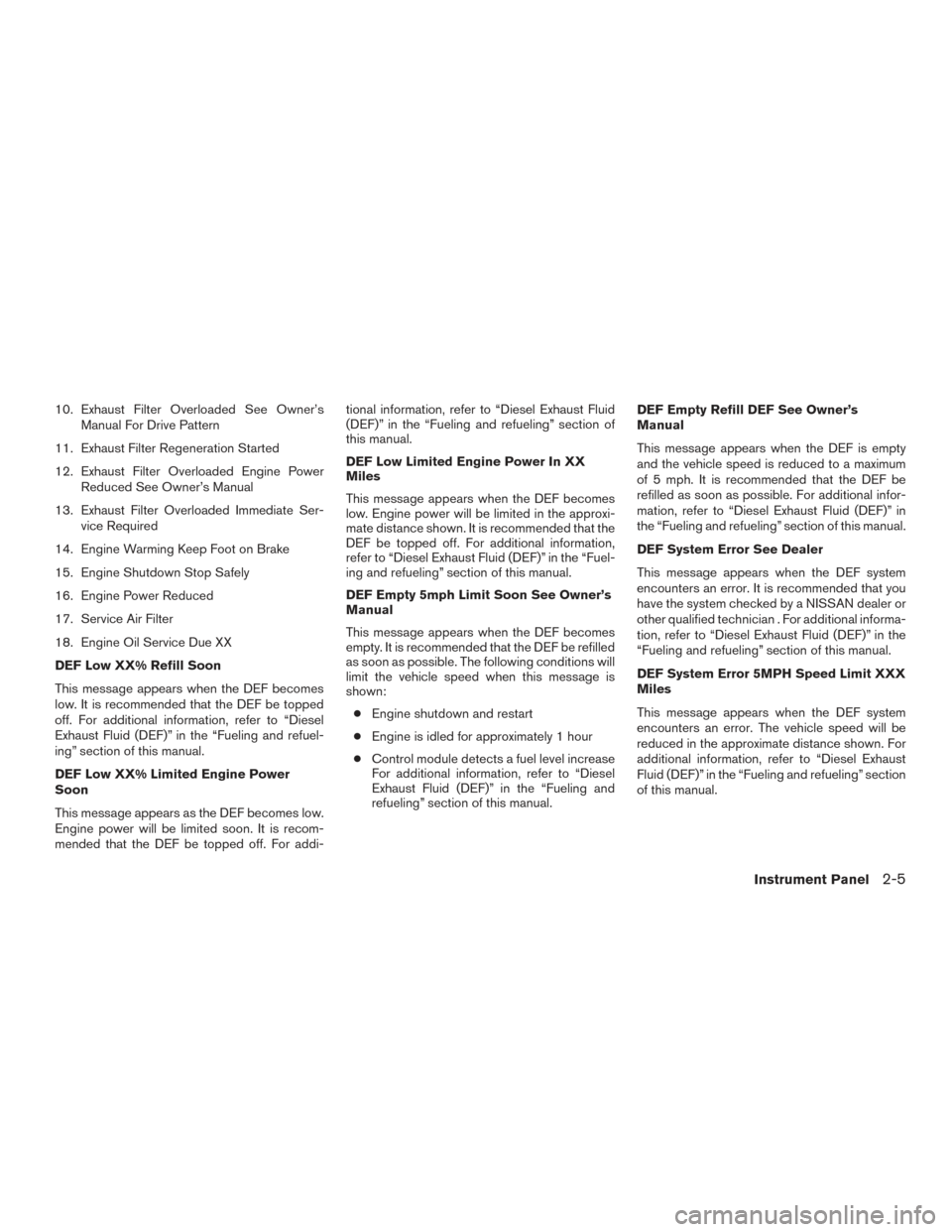
10. Exhaust Filter Overloaded See Owner’sManual For Drive Pattern
11. Exhaust Filter Regeneration Started
12. Exhaust Filter Overloaded Engine Power Reduced See Owner’s Manual
13. Exhaust Filter Overloaded Immediate Ser- vice Required
14. Engine Warming Keep Foot on Brake
15. Engine Shutdown Stop Safely
16. Engine Power Reduced
17. Service Air Filter
18. Engine Oil Service Due XX
DEF Low XX% Refill Soon
This message appears when the DEF becomes
low. It is recommended that the DEF be topped
off. For additional information, refer to “Diesel
Exhaust Fluid (DEF)” in the “Fueling and refuel-
ing” section of this manual.
DEF Low XX% Limited Engine Power
Soon
This message appears as the DEF becomes low.
Engine power will be limited soon. It is recom-
mended that the DEF be topped off. For addi- tional information, refer to “Diesel Exhaust Fluid
(DEF)” in the “Fueling and refueling” section of
this manual.
DEF Low Limited Engine Power In XX
Miles
This message appears when the DEF becomes
low. Engine power will be limited in the approxi-
mate distance shown. It is recommended that the
DEF be topped off. For additional information,
refer to “Diesel Exhaust Fluid (DEF)” in the “Fuel-
ing and refueling” section of this manual.
DEF Empty 5mph Limit Soon See Owner’s
Manual
This message appears when the DEF becomes
empty. It is recommended that the DEF be refilled
as soon as possible. The following conditions will
limit the vehicle speed when this message is
shown:
● Engine shutdown and restart
● Engine is idled for approximately 1 hour
● Control module detects a fuel level increase
For additional information, refer to “Diesel
Exhaust Fluid (DEF)” in the “Fueling and
refueling” section of this manual. DEF Empty Refill DEF See Owner’s
Manual
This message appears when the DEF is empty
and the vehicle speed is reduced to a maximum
of 5 mph. It is recommended that the DEF be
refilled as soon as possible. For additional infor-
mation, refer to “Diesel Exhaust Fluid (DEF)” in
the “Fueling and refueling” section of this manual.
DEF System Error See Dealer
This message appears when the DEF system
encounters an error. It is recommended that you
have the system checked by a NISSAN dealer or
other qualified technician . For additional informa-
tion, refer to “Diesel Exhaust Fluid (DEF)” in the
“Fueling and refueling” section of this manual.
DEF System Error 5MPH Speed Limit XXX
Miles
This message appears when the DEF system
encounters an error. The vehicle speed will be
reduced in the approximate distance shown. For
additional information, refer to “Diesel Exhaust
Fluid (DEF)” in the “Fueling and refueling” section
of this manual.
Instrument Panel2-5
Page 622 of 671

DEF System Error 5MPH Speed Limit
Soon
This message appears when the DEF system has
encountered an error. The following conditions
will reduce the vehicle speed when this message
is shown:● Engine shutdown and restart
● Engine is idled for approximately 1 hour
● Control module detects a fuel level increase
For additional information, refer to “Diesel Ex-
haust Fluid (DEF)” in the “Fueling and refueling”
section of this manual.
DEF System Error 5MPH Speed Limit: See
Dealer
This message appears when the DEF system
encounters an error and the vehicle speed is
reduced. It is recommended that you have the
system checked by a NISSAN dealer or other
qualified technician. For additional information,
refer to “Diesel Exhaust Fluid (DEF)” in the “Fuel-
ing and refueling” section of this manual.
Exhaust Filter Overloaded: See Owner’s
Manual For Drive Pattern
This message appears when the diesel particu-
late filter starts to overload. The Diesel Particulate
Filter (DPF) warning light will also illuminate. When this message is seen, the vehicle
should be driven on the highway where the
road conditions safely allow and the speed
limit permits, over 55 mph (90 km/h) for at
least 45 minutes.
For additional information,
refer to “Diesel Particulate Filter (DPF)” in the
“Do-it-yourself” section of this manual.
Exhaust Filter Regeneration Started
This message appears when the automatic re-
generation has started to clean the exhaust filter.
For additional information, refer to “Diesel Par-
ticulate Filter (DPF)” in the “Do-it-yourself” sec-
tion of this manual.
Exhaust Filter Overloaded Engine Power
Reduced: See Owner’s Manual
This message appears when the diesel particu-
late filter starts to overload. Engine torque and
speed will be reduced. The Diesel Particulate
Filter (DPF) warning light will also blink.
If the Malfunction Indicator Light (MIL) is off, the
vehicle should be driven on the highway where
the road conditions safely allow and the speed
limit permits, over 55 mph (90 km/h) for at least
45 minutes.
If the MIL illuminates, the exhaust filter cannot be
regenerated by driving the vehicle. It is recom-
mended that you have the system checked by a
NISSAN dealer or other qualified technician. For additional information, refer to “Diesel Par-
ticulate Filter (DPF)” in the “Do-it-yourself” sec-
tion of this manual.
Exhaust Filter Overloaded Immediate Ser-
vice Required
This message appears when the diesel particu-
late filter is overloaded. The Diesel Particulate
Filter (DPF) warning light blinks quickly and the
Malfunction Indicator Lamp (MIL) illuminates.
When this message is displayed, the engine
speed and torque will be reduced. It is recom-
mended that you visit a NISSAN dealer or quali-
fied technician immediately. For additional infor-
mation, refer to “Diesel Particulate Filter (DPF)” in
the “Do-it-yourself” section of this manual.
Engine Warming Keep Foot on Brake
This message appears during cold start condi-
tions when:
● Brake pedal is depressed
● Push-button start button has been pressed
● Coolant temperature is below threshold
Keep foot on brake until engine starts, which can
take up to approximately 4 seconds. For addi-
tional information, refer to “Starting the diesel
engine” in the “Starting and stopping the engine”
section of this manual.
2-6Instrument Panel
Page 627 of 671
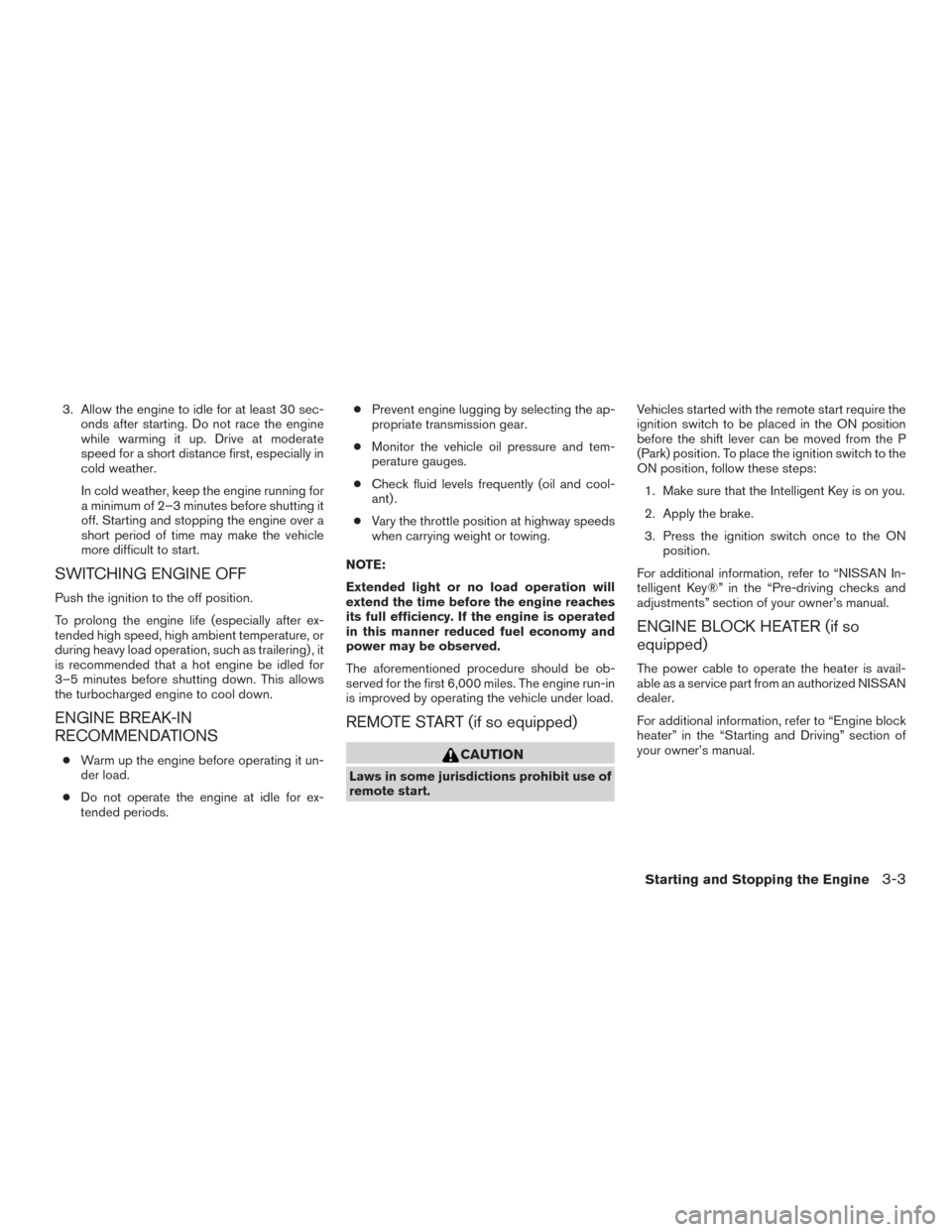
3. Allow the engine to idle for at least 30 sec-onds after starting. Do not race the engine
while warming it up. Drive at moderate
speed for a short distance first, especially in
cold weather.
In cold weather, keep the engine running for
a minimum of 2–3 minutes before shutting it
off. Starting and stopping the engine over a
short period of time may make the vehicle
more difficult to start.
SWITCHING ENGINE OFF
Push the ignition to the off position.
To prolong the engine life (especially after ex-
tended high speed, high ambient temperature, or
during heavy load operation, such as trailering) , it
is recommended that a hot engine be idled for
3–5 minutes before shutting down. This allows
the turbocharged engine to cool down.
ENGINE BREAK-IN
RECOMMENDATIONS
● Warm up the engine before operating it un-
der load.
● Do not operate the engine at idle for ex-
tended periods. ●
Prevent engine lugging by selecting the ap-
propriate transmission gear.
● Monitor the vehicle oil pressure and tem-
perature gauges.
● Check fluid levels frequently (oil and cool-
ant) .
● Vary the throttle position at highway speeds
when carrying weight or towing.
NOTE:
Extended light or no load operation will
extend the time before the engine reaches
its full efficiency. If the engine is operated
in this manner reduced fuel economy and
power may be observed.
The aforementioned procedure should be ob-
served for the first 6,000 miles. The engine run-in
is improved by operating the vehicle under load.
REMOTE START (if so equipped)
CAUTION
Laws in some jurisdictions prohibit use of
remote start. Vehicles started with the remote start require the
ignition switch to be placed in the ON position
before the shift lever can be moved from the P
(Park) position. To place the ignition switch to the
ON position, follow these steps:
1. Make sure that the Intelligent Key is on you.
2. Apply the brake.
3. Press the ignition switch once to the ON position.
For additional information, refer to “NISSAN In-
telligent Key®” in the “Pre-driving checks and
adjustments” section of your owner’s manual.
ENGINE BLOCK HEATER (if so
equipped)
The power cable to operate the heater is avail-
able as a service part from an authorized NISSAN
dealer.
For additional information, refer to “Engine block
heater” in the “Starting and Driving” section of
your owner’s manual.
Starting and Stopping the Engine3-3
Page 637 of 671
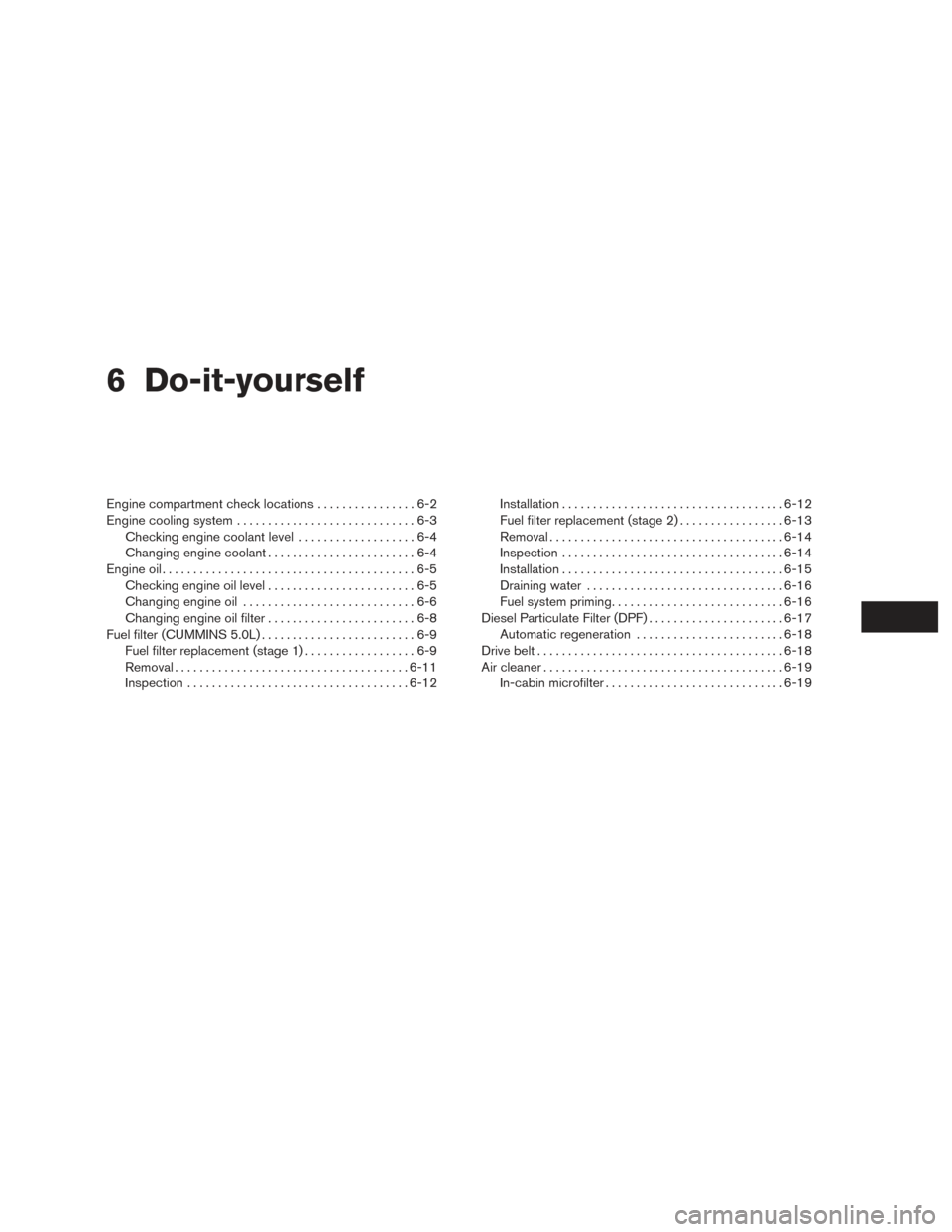
6 Do-it-yourself
Engine compartment check locations................6-2
Engine cooling system .............................6-3
Checking engine coolant level ...................6-4
Changing engine coolant ........................6-4
Engine oil .........................................6-5
Checking engine oil level ........................6-5
Changing engine oil ............................6-6
Changing engine oil filter ........................6-8
Fuel filter (CUMMINS 5.0L) .........................6-9
Fuel filter replacement (stage 1) ..................6-9
Removal ...................................... 6-11
Inspection .................................... 6-12Installation
.................................... 6-12
Fuel filter replacement (stage 2) .................6-13
Removal ...................................... 6-14
Inspection .................................... 6-14
Installation .................................... 6-15
Draining water ................................ 6-16
Fuel system priming ............................ 6-16
Diesel Particulate Filter (DPF) ......................6-17
Automatic regeneration ........................ 6-18
Drive belt ........................................ 6-18
Air cleaner ....................................... 6-19
In-cabin microfilter ............................. 6-19